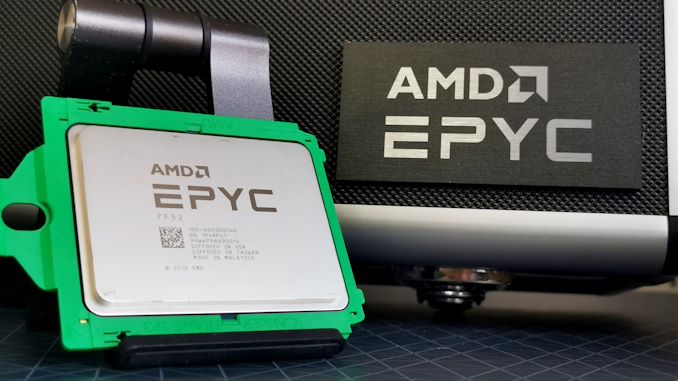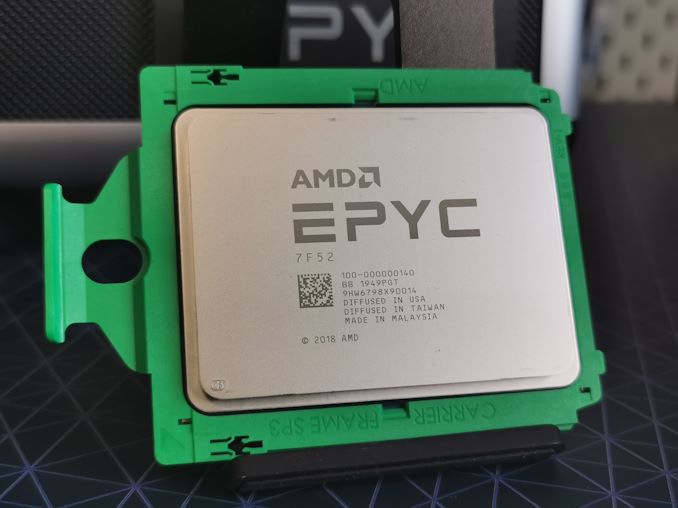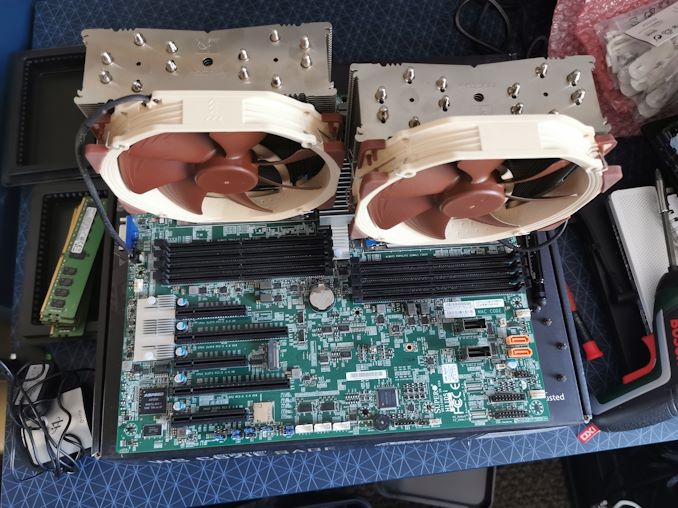AMD’s New EPYC 7F52 Reviewed: The F is for ᴴᴵᴳᴴ Frequency
by Dr. Ian Cutress on April 14, 2020 9:45 AM EST- Posted in
- CPUs
- AMD
- Enterprise
- Enterprise CPUs
- EPYC
- SP3r2
- CPU Frequency
- Rome
- 7Fx2

Everyone wants a fast processor. The ability to get more stuff done is one of a number of guiding principles of business. However, business also needs consistency, safety and security, which is why having enterprise-class processors is often a requirement in the back-end infrastructure. These processors, with lots of cores, aren’t as fast as consumer processors, so it becomes a tussle whether it makes sense to go fast without security, or to play it safe with a proven platform. With AMD’s new 7F processors, the aim is to provide that proven platform with super-fast cores with lots of cache. We’ve got the 7F52 in for testing today.
The Enterprise Market Wants It All
The nature of enterprise processors in recent generations has tended towards more cores and more cache. As power budgets have increased, in order to ensure stability and get the best efficiency points, the solution has been to add more cores. However, there are still markets that want high frequency components, and quite often users will look at consumer hardware, which doesn’t offer the trimmings of the enterprise world, such as ECC memory, RAS features, management, and high-speed IO. We’ve seen OEMs build servers on super rare ‘consumer-grade’ processors, like the auction-only 5 GHz 14-core parts that offer the peak of performance, but fall down on basic enterprise features, such as ECC memory.
To that end, AMD’s Enterprise division has been developing some high-frequency processors within its EPYC line of hardware to address this market. We saw with the first generation ‘Naples’ EPYC processors AMD come out with a special EPYC 7371 processor, which offered 16 cores but had +700 MHz on the base frequency and +900 MHz on the turbo frequency compared to the next best 16-core part, and the tradeoff was only +30 W of power and paying a bit extra. At the time the EPYC 7371, which was launched several months after the rest of the product line, was a test run for what is this new line of 7F ‘high frequency’ processors.
AMD 7F and 7H: Targeting High Performance
The best way to consider AMD’s EPYC processor line, especially for the second generation ‘Rome’ hardware, is in four segments.
First is the main stack. These are the regular processors for the majority of the market, from the 7252 with eight cores all the way up to the 7742 with 64 cores. These are all dual-socket compatible, and are anywhere from 155 W to 225 W (except the 7252 and 7262 which are 120 W).
| AMD EPYC 7002 'Rome' Processors (2P) | ||||||
| Cores Threads |
Frequency (GHz) | L3 | TDP | Price | ||
| Base | Max | |||||
| EPYC 7742 | 64 / 128 | 2.25 | 3.40 | 256 MB | 225 W | $6950 |
| EPYC 7702 | 64 / 128 | 2.00 | 3.35 | 256 MB | 200 W | $6450 |
| EPYC 7642 | 48 / 96 | 2.30 | 3.20 | 256 MB | 225 W | $4775 |
| EPYC 7552 | 48 / 96 | 2.20 | 3.30 | 192 MB | 200 W | $4025 |
| EPYC 7542 | 32 / 64 | 2.90 | 3.40 | 128 MB | 225 W | $3400 |
| EPYC 7502 | 32 / 64 | 2.50 | 3.35 | 128 MB | 200 W | $2600 |
| EPYC 7452 | 32 / 64 | 2.35 | 3.35 | 128 MB | 155 W | $2025 |
| EPYC 7402 | 24 / 48 | 2.80 | 3.35 | 128 MB | 155 W | $1783 |
| EPYC 7352 | 24 / 48 | 2.30 | 3.20 | 128 MB | 180 W | $1350 |
| EPYC 7302 | 16 / 32 | 3.00 | 3.30 | 128 MB | 155 W | $978 |
| EPYC 7282 | 16 / 32 | 2.80 | 3.20 | 64 MB | 120 W | $650 |
| EPYC 7272 | 12 / 24 | 2.90 | 3.20 | 64 MB | 155 W | $625 |
| EPYC 7262 | 8 / 16 | 3.20 | 3.40 | 128 MB | 120 W | $575 |
| EPYC 7252 | 8 / 16 | 3.10 | 3.20 | 64 MB | 120 W | $475 |
Second are the single socket processors. These are variants of the main stack but designated with a P at the end, as these are built for systems that only require a single processor. The benefit here is that the P processors are actually cheaper ($2600 for the 32-core 7502 compared to $2300 for the 7502P) if the customer can guarantee they never need a dual socket design. These also go from 8 cores all the way up to 64 cores.
| AMD EPYC 7002 Rome Processors (1P) | ||||||
| Cores Threads |
Frequency (GHz) | L3 | TDP | Price | ||
| Base | Max | |||||
| EPYC 7702P | 64 / 128 | 2.00 | 3.35 | 256 MB | 200 W | $4425 |
| EPYC 7502P | 32 / 64 | 2.50 | 3.35 | 128 MB | 200 W | $2300 |
| EPYC 7402P | 24 / 48 | 2.80 | 3.35 | 128 MB | 200 W | $1250 |
| EPYC 7302P | 16 / 32 | 3.00 | 3.30 | 128 MB | 155 W* | $825 |
| EPYC 7232P | 8 / 16 | 3.10 | 3.20 | 32 MB | 120 W | $450 |
| *170W TDP mode also available | ||||||
Third is the 7H family of processors, which as it stands only has one member right now. This was launched a couple of months after the first two segments, and the ‘H’ stands for High Performance Computing. The power limits of this chip has increased up to 280 W, and the goal is to drive a higher sustained frequency than the regular parts. For example, the 7742 has a base frequency of 2.25 GHz at 225W, but the 7H12 has a base frequency of 2.60 GHz at 280 W. The 7H processors aren’t on general retail as far as we can tell, but specific customers can request them.
| AMD EPYC 7H Rome Processors (1P) | ||||||
| Cores Threads |
Frequency (GHz) | L3 | TDP | Price | ||
| Base | Max | |||||
| EPYC 7H12 | 64 / 128 | 2.60 | 3.30 | 256 MB | 280 | $? |
Fourth is the newest set of hardware, the 7F family. The F in this case is for Frequency, and these parts are spiritual successors to the 7371 in the last generation: a lot more base frequency and a lot higher turbo for the consumer to use. AMD is also equipping these processors with lots of cache, so the cache per core can effectively quadruple.
There are three members to the Rome 7F family:
| AMD EPYC 7F Rome Processors (1P) | ||||||||
| Cores Threads |
Frequency (GHz) | L3 | TDP | Chiplets | Cores per CCX |
Price | ||
| Base | Max | |||||||
| EPYC 7F72 | 24 / 48 | 3.20 | 3.70 | 192 MB | 240 W | 6 | 2 | $2450 |
| EPYC 7F52 | 16 / 32 | 3.50 | 3.90 | 256 MB | 240 W | 8 | 1 | $3100 |
| EPYC 7F32 | 8 / 16 | 3.70 | 3.90 | 128 MB | 180 W | 4 | 1 | $2100 |
These processors do look a little confusing.
For the 8 core 7F32 and the 16 core 7F52, AMD is enabling 1 core per CCX, or 2 cores per chiplet, which means the equivalent of 16 MB of L3 cache per core. This is four times as much as what any other AMD EPYC processor gets.
The 24 core 7F72 is cheaper than the 16 core, as AMD is adjusting the level of cache on offer here to 192 MB. This means that this processor only has six of the eight chiplets active, and each CCX will have two cores active (6 chiplets * 2 CCX per chiplet * 2 cores per CCX = 24). The frequency is a little bit lower because of the increased active core density, so along with the decreased cache, AMD felt the need to price this one below that of the 7F52.
For this review, we’re testing the 7F52 processors. Compared to the base 7302 16-core that AMD offers, this means another +500 MHz on the base frequency, and +600 MHz on the turbo frequency, but also going up from 155 W to 225 W.
Naturally some of the key comparison points for the 7F52 CPU are going to be equivalent 16-core CPUs from Intel, such as the new Xeon Gold 6226R, or comparisons to 28/32 core options from both Intel and AMD.
| 7F52 2P Comparison Points | ||||
| AMD 7F52 (2P) |
AMD 7601 |
AnandTech | Intel 8280 |
Intel 6226R (2P) |
| 2 x 16 / 32 | 32 / 64 | Cores / Threads | 28 / 56 | 2 x 16 / 32 |
| 3500 | 2200 | Base Frequency | 2700 | 2900 |
| 3900 | 3200 | Turbo Frequency | 4000 | 3900 |
| 2 x 256 MB | 64 MB | L3 Cache | 38.5 MB | 2 x 22 MB |
| DDR4-3200 | DDR4-2666 | DRAM Support | DDR4-2933 | DDR4-2933 |
| 2 TB / socket | 2 TB | DRAM Capacity | 1 TB | 1 TB / socket |
| 2 x 240 W | 180 W | TDP | 205 W | 2 x 150 W |
| 2 x $3100 | $4200 | Price | $10008 | 2 x $1300 |
In our tests today, we’re using Supermicro’s H11DSi motherboard for testing the 2P EPYC processors, the ASRock Rack EPYCD8 for the 1P configurations, the ASUS WS C621E SAGE for 2P Xeon, and the ASUS ROG Dominus Extreme for 1P Xeon. Many thanks to Kingston for supplying memory for this review, as well as Micron for both memory and storage, Corsair for the power supplies, and Noctua for the coolers.












97 Comments
View All Comments
Oxford Guy - Saturday, April 18, 2020 - link
" No one in their right mind would evaluate a server CPU, designed for datacenters against a consumer CPU that will never see the light of day. WTB a real data center oriented website.. you consumers are just annoying when it comes to this stuff."Is there any kind of metric about ECC vs. non-ECC RAM, in terms of cost-benefit ratio? It's not all about CPU speed. It's also about data stability, correct?
How much value does ECC RAM bring to the table? That information seems to be critical when comparing consumer CPUs to enterprise and prosumer CPUs.
twtech - Monday, April 20, 2020 - link
Generally that may be the case. However, this CPU may be considered as an option for workstations. For that use case, it's nice to know how it stacks up against consumer CPUs, HEDT, TR, etc.DanNeely - Tuesday, April 14, 2020 - link
Can you borrow Johan's server benchmarks as a baseline for building your own out?Ivan Argentinski - Tuesday, April 14, 2020 - link
Hi Ian,I am big fan of Anandtech. But I have always missed articles, relevant to me. I am a decision maker for database servers for ERP (among other things). We heavily employ frequency-optimized processors and I feel I can shed some light on the subject.
Unfortunately, I feel like the article (and just about everybody) is partially missing the point of these processors. Frequency optimized processors are a niche product. They have only one use-case - for enterprise software, which is licensed per-core (like Microsoft SQL Server). So, it is irrelevant to discuss them in any other role.
Per-core performance is not the same as single-threaded performance. Also, it is not lightly threaded performance. It is also not multi-thread performance, e.g. total CPU power. All these are irrelevant. We pay for SQL Server per core, per month. And it is costly. The CPU cost is nothing, compared to this. However, the total number of frequency-optimized cores we can cram in a server matters to some extent. Hence, the new 7F52 totally makes sense and I guess it will be the best-selling 7Fx2 CPU. If I can get 32 high-per-core-performant cores in a 2P server, it would be great.
For example, our servers are usually 40-70% loaded during peak times of the day (with some 100% bursts). The thing that matters the most is how each core is handling, while all cores are loaded. This can be roughly stated as:
Per-core Perf = Total Perf / Number of cores
Hence, it is meaningless for this niche to:
- Measure single threaded workloads
The CPU can trick us by leveraging single-thread boost, which never happens in production.
- Compare total CPU performance
If the CPUs have different number of cores, this is meaningless. If we need more performance, we can just purchase more CPUs/servers.
- Compare the CPU to non-frequency optimized CPUs
These will just plain loose in per-core performance. But, on second thought, it would be fun to know what the actual difference is!
- Compare to desktop or other kinds of CPUs.
We just can’t use these in the data center. And if you are not purchasing for a data center and for a per-core software, then frequency optimized CPUs are not for you. Again, maybe just for fun.
What if meaningful to compare for F-CPUs:
- Per-core performance
Throw heavy multi-threaded workload, then divide by the number of cores and see what you get for each CPU.
- Watts for a unit of per-core perf
Power is the other thing we are paying for.
- $ for a unit of per-core perf
Not of utmost importance, but still relevant.
Ideas for relevant test scenarios:
- 1P * 7F52
- 2P * 7F52
- 2P * 7F32
- 2P * Gold 6250
- 2P * Gold 6244 (our current setup)
- 2P * Gold 6244, but with less DIMMs than memory channels (if you initially buy with less RAM, how much perf are you loosing?)
Tests, relevant to databases:
- OLTP - tpm
- OLAP - qph
If I have these figures, it can actually alter my purchasing behavior.
Good Luck and all the best to you and the team!
romrunning - Tuesday, April 14, 2020 - link
Agreed - more enterprise-focused tests would be more relevant to this enterprise-focused EPYC.I also would have liked to see VM tests and database tests.
Icehawk - Wednesday, April 15, 2020 - link
Agreed, not quite as relevant for this specific SKU but I’ve been wanting to see VM testing for ages along with a lot of other server related testing like SQL performance. Of course consumer is this site’s focus and that’s OK.Atari2600 - Tuesday, April 14, 2020 - link
Hey Ivan, you prob need to go look at servethehome.comAs I'm sure your well aware, Anand is much more consumer focused with a benchmarking philosophy geared toward that.
Oxford Guy - Saturday, April 18, 2020 - link
What is the point of discussing $7000 CPUs, or even $3000 CPUs if you're only going to be "consumer-focused"?The only point I can think of is to try to convince people to buy some company's other product via mindshare (i.e. marketing).
brucethemoose - Tuesday, April 14, 2020 - link
Could you link those 2 benchmarks?Ian Cutress - Tuesday, April 14, 2020 - link
Hey Ivan,Thanks for the input, it means a lot. This was a rush review for sure, I had to pool some data and retest some as well. Unfortunately our stock of enterprise CPUs isn't great - I don't have the 7371 frequency optimized ones from the previous generation, nor any of Intel's. I'll be getting the 7F32 and 7F72 parts in soon though, so perhaps I can work a bit more to that.
I also need to do some research into developing these benchmarks. Some serious 'explain it like I'm a five-year-old' guides of what to download from where, how to install it, what commands to run, etc. I also want some proper system power monitoring tools. The usual fare that US reviewers use, like Watts Up units, aren't sold outside the US, and I've been after something for a while.
I'll certainly take heed of the metrics that users like yourself require, and work them into future reviews as I can.